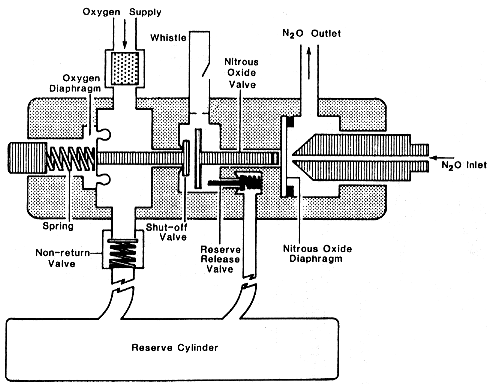Chris Thompson - USyd Lectures Listing The Anaesthetic Machine: Yokes, Regulators, Line Connectors etc
YOKES Mechanical system for fitting cylinders securely to the machine. Components usually include:
The junction between cylinder and yoke is rendered airtight by a 'Bodok seal', otherwise known as CGA 870 seal. These consist of a metal ring surrounding a neoprene (or other elastomeric) washer. The metal ring limits compression of the neoprene when the cylinder is screwed onto the yoke, and also stops it expanding outwards under gas pressure. With these type of seals an airtight cylinder-yoke connection requires little force.
CHECK VALVES Usually placed in-line immediately at the cylinder connection point (i.e. within the yoke) - may leak, but should not exceed 10ml/min. Unused yokes should be plugged.
Gauges indicating cylinder pressure should be visible from the front of the machine. They are usually Bourdon type (twisted metal tube that straightens as pressure rises, connected by small gears to the needle at front). Require adjustment from time to time. Note that the nitrous cylinder gauge will remain high until about 87% of the cylinder is empty, then fall (relatively) rapidly, because the pressure does not drop until all the liquid has evaporated. REGULATORS Functions Reduce high cylinder pressures (up to 20,000kPa) to lower, workable levels (usually 350 - 380kPa) for use in secondary systems in machines (gas mixing, ventilator drive) maintain constant 'downstream' pressure despite changes in 'upstream' (i.e. cylinder) pressure, so that gas flows delivered by simple mixers (e.g. needle valves) won't change as cylinders empty Design A diaphragm inside the regulator separates the outlet side from an opposing spring. The location of the diaphragm depends mostly on outlet pressure (for a given spring tension). If outlet pressure falls, the spring opens a needle valve attached to the diaphragm, increasing gas delivery (and vice versa). The nominal outlet pressure can be fine-tuned by adjusting the spring tension.
DIRECT ACTING:
SECOND STAGE / DUAL REGULATORS
Notes:
Line O2 pressures can drop intermittently to below 350kPa if the ventilator is driven by O2 (esp. Campbell's), if pipes are old and if usage is high. This can unexpectedly empty an open O2 cylinder. The other cause is a leaky bodok seal. Hence the general rule to keep unused cylinders turned off. Old needle-valve machines run the line gas supply directly to the rotameters (at 400kPa). On switching to cylinders, flow falls in proportion to the percentage pressure drop from line to cylinder (typically 10%), providing an indication of the regulator setpoint. If there is a second regulator before the rotameters there will be no drop in flow. Machines with anti-hypoxia devices run on much lower internal operating pressures, with the first stage regulator working as above and the second stage regulator accurately regulating both line and cylinders. e.g. Ulco 615 runs internally at 200kPa. Most new machines with electronic mixers only need a first-stage regulator (for the cylinders), because the mixing system can happily handle a very wide range of input pressures (e.g., Dräger Primus works down to 270kPa). These days most 'intermediate pressure' gas lines are stiff, small plastic hoses. Safety issues: Overpressure relief valve - usually internal, at 600kPa, to prevent diaphragm rupture. Non-corrosive, non-flammable construction. Sudden cylinder opening can cause abrupt pressure rises and compressive temperature increases, which can rupture the regulator diaphragm and in the case of O2 could cause a fire if oil etc was present in the regulator. High gas usage can cause adiabatic (expansion) cooling, potentially leading to freezing and jamming (very rare). Diaphragm failure in indirect regulators causes the spring to fully open needle valve. If this happened on the nitrous reg in an old machine (i.e. without second stage regulators or electronic mixers), the mixture would become hypoxic. Usually happens when quickly opening full cylinders. Cylinders should always be opened slowly! 'Cracking' a cylinder (briefly opening it to flush the valve outlet clean before attaching the cylinder to the machine) has been advocated if the plastic cover has been removed. LINE CONNECTIONS Hoses are colour coded. High pressure gas connectors on anaesthetic machines are usually Sleeve Indexed (SIS) and have integral check valves to prevent loss of gas from the machine when hoses are disconnected. Oxygen outlet connectors intended to drive ventilators do not have check valves. Scavenging SIS diameters are different from normal suction. OXYGEN SUPPLY FAILURE ALARMS Most mechanical machines are fitted with an 'oxygen failure device' that provides a gas-powered auditory alarm and disconnects the nitrous oxide from the circuit when the oxygen supply fails. Current devices are variants of the Howison type: Nitrous disconnected if O2 falls below 275kPa; 800ml reservoir opens at 150kPa .
Howison-type oxygen-powered whistle with nitrous shutoff.
See Also: Equipment notes by Mark Finnis |
||||
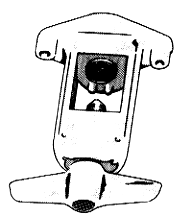
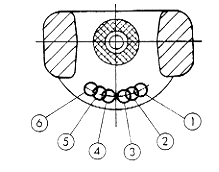

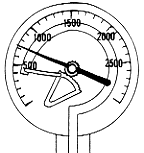 PRESSURE GAUGES
PRESSURE GAUGES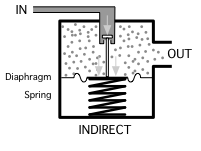
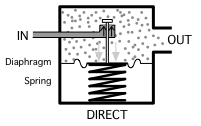
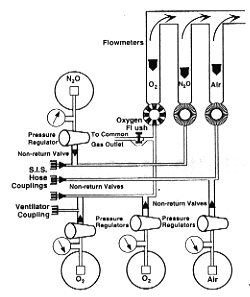 Line pressure is nominally 414kPa. Regulator pressures are set below this, so that the regulator is 'off' all the time. When line pressure drops below regulator opening pressure, the regulator will automatically supply gas if the cylinder is open.
Line pressure is nominally 414kPa. Regulator pressures are set below this, so that the regulator is 'off' all the time. When line pressure drops below regulator opening pressure, the regulator will automatically supply gas if the cylinder is open. 